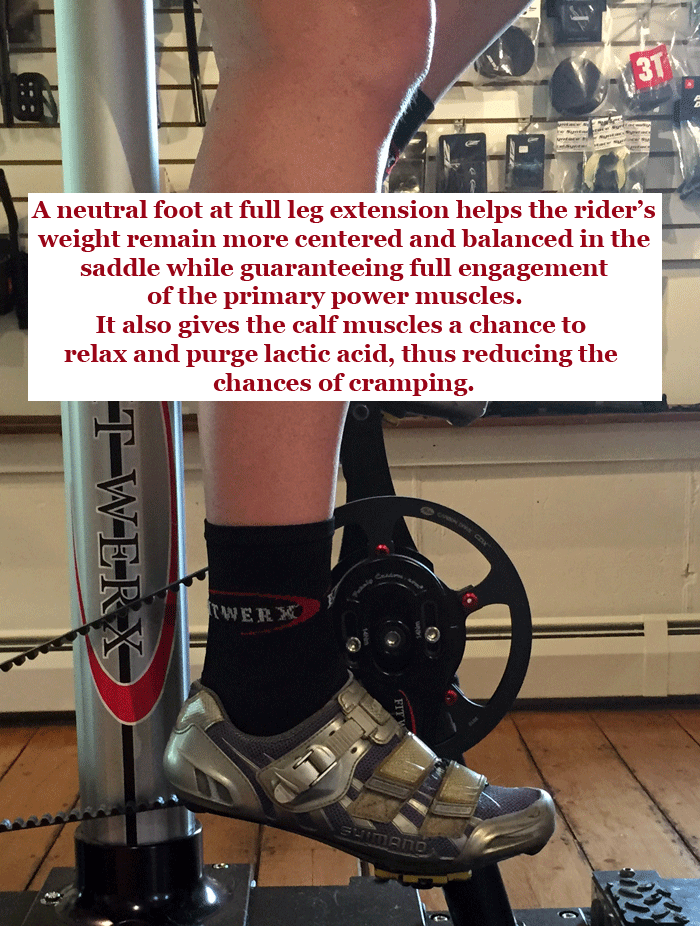Chronic Saddle Discomfort. Part 1 – Toe Pointing
Some of the more common chronic ailments riders have are saddle discomfort issues. Whether it is friction and sores; numbness and pressure on the soft tissue up-front; or sore sit bones, saddle discomfort on a bicycle is no fun at best and extremely limiting at worst. While proper bike fit/set-up and saddle selection can solve saddle issues for many riders, problems persist for others and the result is usually a big box of saddles and painful frustration. So, if you know your bike is well fit and you still aren’t finding happiness with saddles, what else might be going on?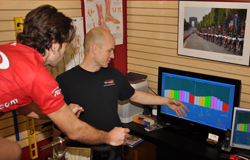
I don’t have scientific evidence, but I would be willing to bet that, for riders with a well set-up/fit bike, riding technique and posture are by far the biggest contributors to chronic saddle discomfort. In a Fit Werx fitting, we spend a significant portion of the fitting with many riders discussing their posture and pedaling technique on the bike. Why? Because almost no one received training as to what ideal riding posture entails when they learned to ride a bike; almost all of us were pushed down the road by our parents until we could balance and that was where the technique “training” ended. In a Fit Werx bike fitting, we work to get you pedaling in your goal posture and we provide you with motion capture video and still shots so that you can review the results in the future and continue to work on it. If you have had a fitting with us at Fit Werx in the past and are still having saddle discomfort issues, start by looking at your videos and reviewing the comments related to each.
Posture and technique related items can be very hard to change; it can take a concerted effort to break habits and muscle recruitment that has been developed over many years of 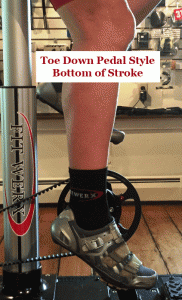 riding. This being said, proper technique is absolutely crucial to solving some of the most chronic problems. There are a host of combined technique items that often relate to saddle issues and trying to explain all of the
riding. This being said, proper technique is absolutely crucial to solving some of the most chronic problems. There are a host of combined technique items that often relate to saddle issues and trying to explain all of the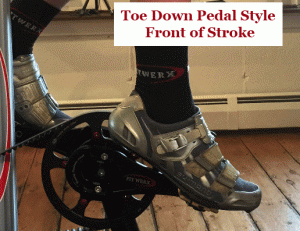 m at once would be overwhelming. For this reason, this article is going to focus on just one technique aspect that leads to a lot of saddle issues – pointing your toes at the front to bottom of the pedal stroke.
m at once would be overwhelming. For this reason, this article is going to focus on just one technique aspect that leads to a lot of saddle issues – pointing your toes at the front to bottom of the pedal stroke.
How does pointing your toes down through the front to bottom of the stroke potentially contribute to saddle comfort? It is very difficult to keep your weight balanced on your sit bones and point your toes at the same time. To get an idea as to why, stand on your tip toes and feel how much more forward and less balanced your weight becomes.
Pointing your toes through the high load power portion of the pedal stroke (the front) will naturally encourage you to slide forward and onto the nose of the saddle and thus increase the pressure on the perineum and groin while making you heavy in the hands/neck and shoulders.
Many riders counteract this natural tendency to slide forward by pushing themselves way back on the saddle, hunching or hyper-extending their back, and trying to brace/lock themselves with their arms (straight/locked elbows).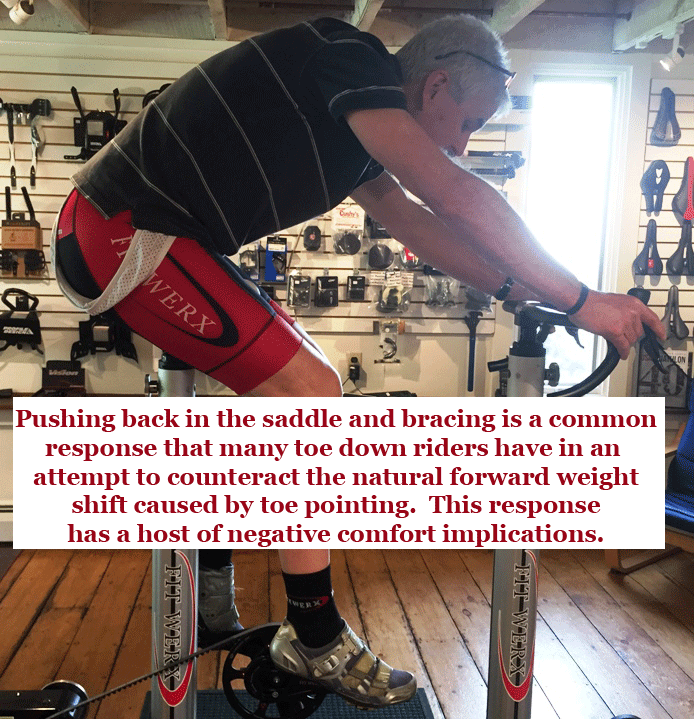
This may make the saddle momentarily more bearable, but can lead to a huge host of other issues including numb/sore hands, sore neck/shoulders/back and an increase in the likelihood of calf or quadriceps cramping. It can even migrate saddle issues from the soft tissue to the sit bones.
You can see how just this one small technique item can have kinetic chain implications that go well beyond just the saddle.
For these reasons, we advocate that you keep your feet neutral as you push down on the pedals through the front of the stroke and until you are at full leg extension near the bottom of the stroke. What does “neutral” mean? In cycling, this means a fairly level foot where the toe of the shoe will be just a little lower than the heel (say 10 degrees on the average). This angle helps you maintain an even and balanced position in the saddle with the majority of your weight planted firmly, but not exclusively, on your sit bones and with as little side-to-side or up-and-down rock in the pelvis as possible.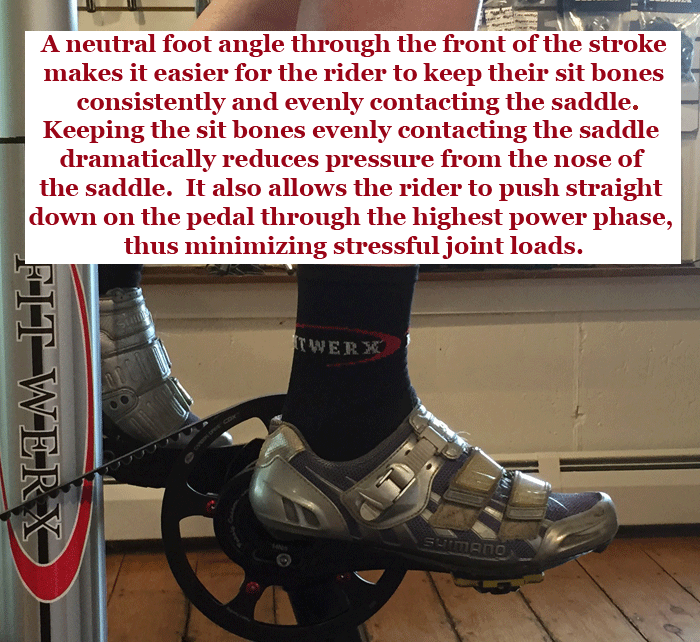
From a musculature standpoint, your goal when pedaling is to use your core/abdominal muscles to keep yourself stable in the saddle while supporting the weight of your torso (thus allowing you to relax your extremities and joints). This has similarities to the posture and muscles you use in the “ready” position in a ball sport (pelvis rotates slightly forward, quads/hamstrings/abdominals all balance you out and support your torso and you are relaxed in the upper body and hands). If you master this fundamental posture in general riding, you will find that keeping weight off the front of the saddle becomes a lot easier and that your desire to hunch or hyper-extend your back, brace with straight arms, or slide forward will diminish greatly. This all starts by making sure that your foot is neutral through the front to bottom of the pedal stroke.
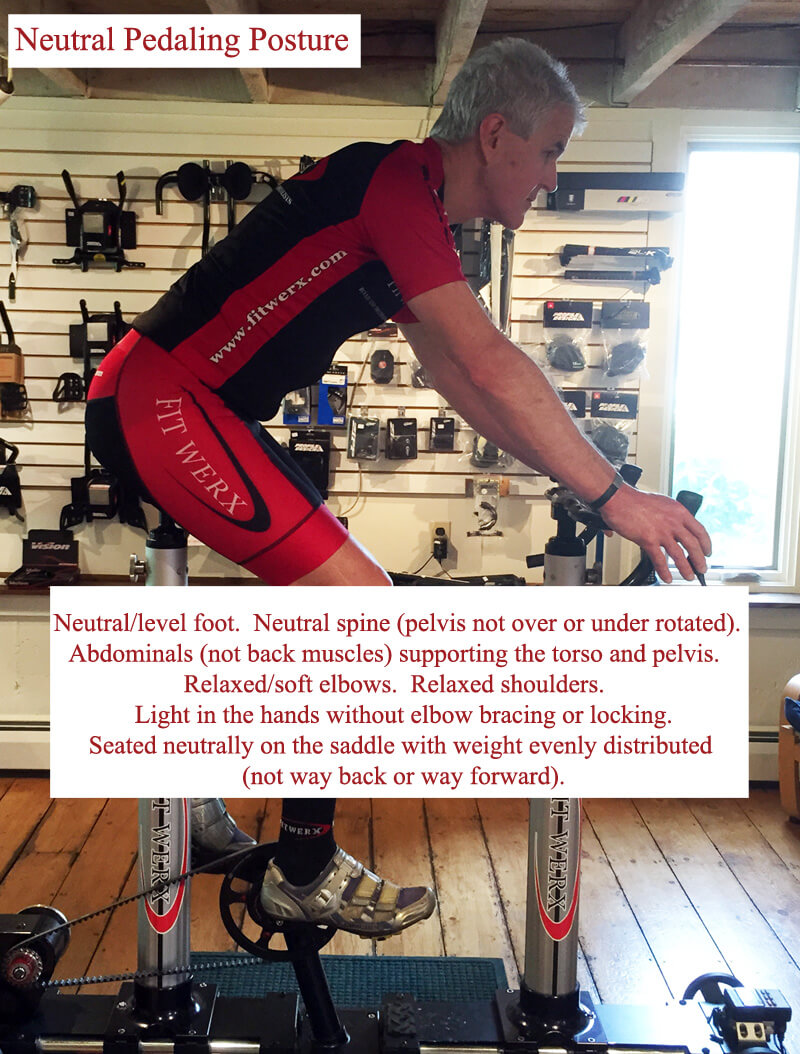 Fit Werx, voted “America’s Best Bike Shop” and named by Bicycling Magazine as a “Must Visit” bike shop, has locations outside of NYC in Ridgefield Park, NJ, in Peabody and Lexington, MA and near Burlington, VT and Stowe, VT in Waitsfield. Fit Werx is changing the way people buy bicycles through their Rider First Bike Fittings and Rider Matched approach to bike sales. Don’t gamble on your next bike or your fit! Contact us for more information.
Fit Werx, voted “America’s Best Bike Shop” and named by Bicycling Magazine as a “Must Visit” bike shop, has locations outside of NYC in Ridgefield Park, NJ, in Peabody and Lexington, MA and near Burlington, VT and Stowe, VT in Waitsfield. Fit Werx is changing the way people buy bicycles through their Rider First Bike Fittings and Rider Matched approach to bike sales. Don’t gamble on your next bike or your fit! Contact us for more information.


